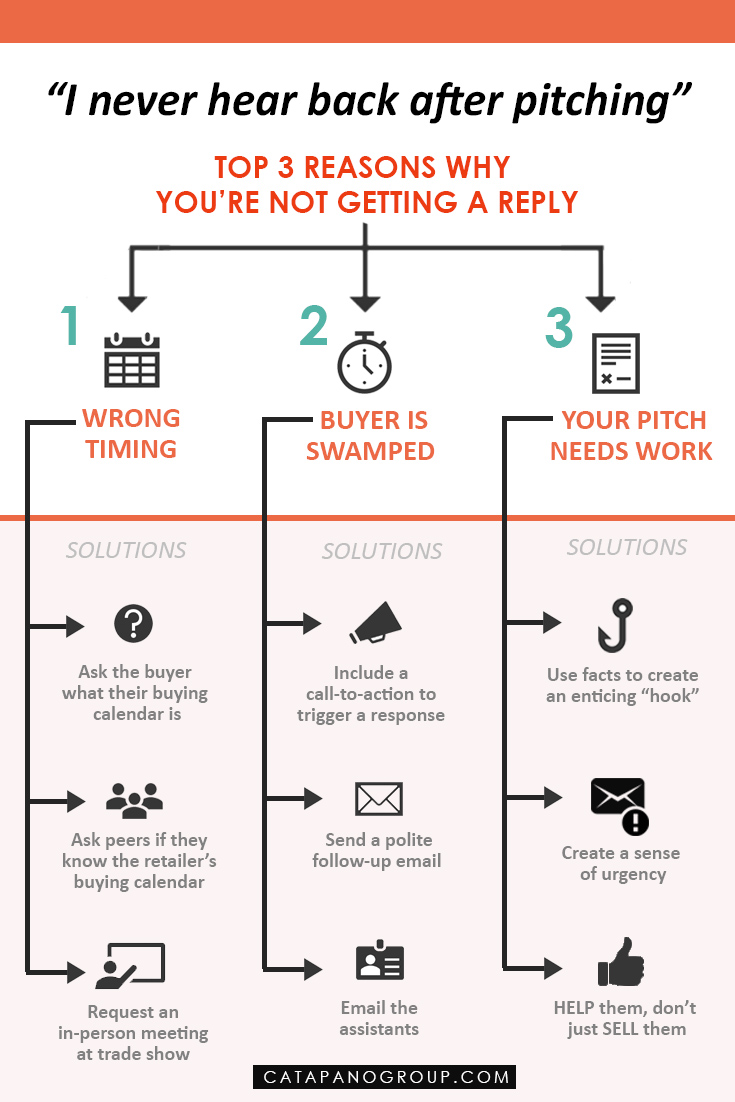

It doesn’t matter how experienced you are, when you put a ton of effort into pitching your product and then don’t hear back, it can be painful and frustrating. Don’t let it get you down.
Even as I write this article, I’m sitting here waiting on 4 important buyers to get back to me. I have their names on post-its above my desk and every time I look up, I’m reminded that they have yet to respond. It stings a bit, but my experience has taught me to brush it off.
I would be lying if I said I always thought this way. There was a moment in my career where I’d let something like this bring me down. And I mean, really bring me down.
But reading a ton of these pitches while working in a corporate buying office of a Fortune 500 retailer made me realize that a lack of response is not indicative of your success or failure.
Rejection is a part of doing business.
You will get rejected no matter how perfect your pitch is. The sooner you can accept this, the better.
That being said, there are strategies you can implement to increase your chances of getting a positive response from a buyer.
Your technique will improve significantly if you can understand the process from the buyer’s perspective. So to help with that, I’m going to share my experiences in a buying office and tell you the top 3 reasons we didn’t respond to vendor pitches.
Top 3 Reasons You Didn’t Get A Response Back and What to Do About It
#1: You Reached Out at the Wrong Time
Some of you who are just starting out may not know this, but buyers operate on a buying calendar.
Each year, a buyer has time set aside to enter the “market” and make purchasing decisions. So rather than shop for new products all day every day, buyers shop for new products during certain time frames.
The money that a buyer is allotted to spend on products (also known as their “open-to-buy dollars”) coincides with this buying calendar.
If I was the buyer of women’s fashion tops, my buying calendar may dictate that I should be “going to market” once a month (that’s retail jargon for, “every month I’m going to see new vendors, and search for new products.”)
Even though a buyer may be going to market every month, his or her open-to-buy (or how much money they have to spend) can vary drastically each time.
For example, a buyer could go to market in January looking for new products and have $100K of open-to-buy, meaning $100K to spend. But then this same buyer can go to market in June and now only have $10K to spend — maybe sales the month prior were tough and he or she doesn’t have enough money to put back into purchasing new product.
Things can vary and that’s why pitching is all about timing. It boils down to how much money the buyer has and at what time he or she is going to spend it next.
Buying calendars vary drastically depending on product type.
Some buyers only “go to market” once or twice a year. Others are “in market” all the time.
The reason it’s important for you to know the calendar is because you want to do your best to pitch buyers at the time they’re looking for new product.
Think about it.
If it’s the middle of July and 85 degrees outside, how likely are you to buy a wool sweater you saw advertised on TV? Not very likely. You don’t need a wool sweater right now! You’re probably more focused on buying bathing suits.
The same thing goes for buyers.
Buyers are looking for certain products at certain times. They also have limited budgets so if you reach out at the wrong time, they may have no more money left to give you an order even if they loved your product.
Knowing the buyer’s decision-making time-frame will help you understand when to reach out, how often to reach out, and when to really put pressure on them.
What to Do
Plan A: Send your email to the buyer 2-4 weeks before their buying time-frame and request an in-person appointment.
If you don’t know the buying calendar, then:
Plan B: Do some research to try to figure it out. Ask showrooms, email peers, or ask other designers who have sold the store you’re targeting.
If you still can’t find it on your own, then:
Plan C: In your FIRST email to the buyer, ask them what their buying calendar looks like. Say something like: “If you’re not looking for new products right now, let me know what your buying time frame is and I’ll touch base with you at a more appropriate time.”
# 2: The Buyer Is Swamped
Sometimes the buyer is just too busy. You might be thinking, “are you kidding me? They’re too busy?!”
But this is a very real issue. Buyers are some of the busiest people on earth. From a distance, it seems like their job is to just review new products and meet new vendors all day long.
That couldn’t be further from the truth. Almost 80% of their time is spent sitting in team meetings, analyzing their sales data, generating reports, coordinating with their advertising and marketing departments, and digging themselves out of piles of paperwork.
It is very possible that the lack of response is the direct result of a busy schedule. I, myself, was guilty of forgetting to answer vendors even though I promised myself I would never “be like them”.
What to Do
#1 – Include a call to action in your FIRST email: Sometimes buyers need to be prompted with a specific question to trigger their reflex to respond. You could say something like: “Will you be attending [name of a tradeshow coming up]? I would love to get an appointment on the calendar so that you can see our collection in person while we’re both at the show.”
This works because you’re asking a direct question that warrants a response and you’re offering an easy meeting place. Buyers like to batch all their vendor visits, so if they will already be attending a tradeshow, it is convenient for them to just add your booth to their list of “go-to’s”.
#2 – Send a polite follow-up email: If you haven’t heard back, my recommendation is to follow up via email. It is important to stay persistent, but respectful. I want to emphasize the word “respectful” because believe it or not, I’ve seen many vendor follow-up emails with a passive aggressive tone like, “as I stated in my 5 emails below…”
The frustration is completely understandable but speaking in this way just defeats the purpose of following up — you’re going to rub the buyer the wrong way and encourage them to not respond to you. Remember, it’s not rude to follow up– it’s your job to close the loop!
#3 – Email the assistants: If the buyer isn’t responding to your follow-ups, find out who the buyer’s assistants are and email them directly. While assistants are not usually able to make buying decisions, it’s their job to make sure the buyer stays in the loop with everything that is going on. Because of that, it is very likely that they will forward your message along to the buyer.
If you don’t know who the assistants are, do a LinkedIn search by typing the product category + the word “assistant.” Merchant Assistant or Assistant Buyer are common titles they go buy.
You can send something like:
“Hi [assistant’s name]
My name is [your name] and I’m trying to get in touch with the (category) buyer. I sent a few emails but think I may have the wrong contact info. Is it possible for you to forward my message below to your buyer?
I appreciate the help!
[Your name]”
Below the message, copy and paste your original pitch (don’t forward).
#3 : Your Pitch Needs Work
Sometimes the lack of response simply boils down to having a pitch that needs work. As someone who has read numerous pitches, there are a few red flags that will make a buyer want to click “DELETE”. The most common pitch mistakes I’ve seen are:
#1 – Talking too much about yourself. Of course, it is important to let the buyer know who you are and what your company is all about, but keep this part of your pitch brief. Don’t forget that the point of the email is to show the buyer what you can do for THEM. Keep your introduction concise and focus on showing them how your product will drive sales.
#2- No enticing facts–lack of a “hook”. Buyers like to hear more about a product that already has traction whether it be through proven sales, buzz in the press, or social media. This is especially true with the big buyers. At the end of the day, the buyer’s job is to pick products that will be successful, so if you are showing them that you already have proof of future success, they will want to hear more.
#3 – Beggy tone. In other words, sounding desperate. A beggy tone implies you don’t have confidence in your product — this happens frequently in vendor pitches. Yes, your goal is to get the buyer to buy, so in a sense you may feel you need them, but it’s important to remember that the buyer needs you just as much as you need them! If they aren’t finding new products to bring into their stores that drive sales, they aren’t doing their job.
Stay confident. Re-read your email. If there are any parts that sound desperate, delete them.
#4- Create a Sense of Urgency. Creating a sense of urgency is one of the most important elements in a pitch yet it was missing over 80% of the emails I’ve seen. Here are two ways to create urgency:
- Offer a special discount that expires. Buyers LOVE taking advantage of “special buys” or discounts because it helps them drive profitability. Entice them by saying something like: “We’re able to offer a [$ or %] discount on [ITEM DESCRIPTION] right now (one of our strongest items) but in order for us to take advantage the better costing, orders must be submitted to our factory by [DEADLINE].”
- Give details about an upcoming marketing event. Part of the buyer’s budget goes to marketing so they can have their products featured in emails, radio, TV, print, etc. Because this stuff isn’t cheap, buyers look for any opportunity to take advantage of FREE marketing. You can say something like: “Our product is going to be featured in [MEDIA SOURCE] in 7 weeks. Last time we were featured, our retail partners saw a significant lift in sales. I would love to get our product in your stores in time for the upcoming feature so you can take advantage of the increase in demand.”
#5 – Remember to Help, Not Just Sell. At the end of the day, no one likes being blatantly “sold” to. When was the last time you walked down the aisle of a department store and were happy to be cut off by someone trying to sell you perfume? It’s annoying and makes you want to leave. Then think about a sales associate that dug through a pile of jeans for you to help you find the size you needed. Chances are, you appreciated the help…and you bought the jeans.
The key difference is that one person tried to SELL you and the other tried to HELP you.
This same concept applies to your pitches to buyers. Ask yourself, “Am I showing the buyer I’m trying to help them? Or am I trying too hard to just sell them?”.
And remember, rejection is a part of doing business—all you have to do is stay positive and stay persistent.


This is a guest post from Rita Catapano, an entrepreneur, consultant, and co-founder of CATAPANO GROUP, where she teaches businesses how to grow their product sales. To get actionable tips and advice on selling your product to large retail stores, enroll in her free 6-day email course Retail Rundown™ here.

Eloise
Thank you for the reminder! Keep hustling and do it at the right time in the right way. The buying calendar is so important. Everyone is busy and making it easy is key. Will be looking back over our procedures and tidying them up. Thank you.